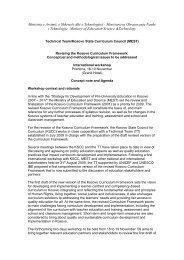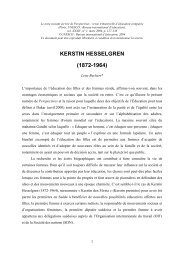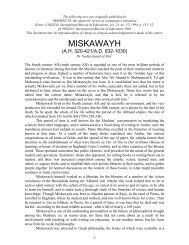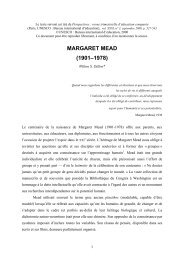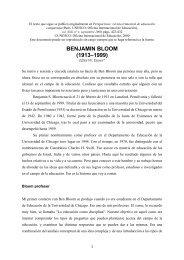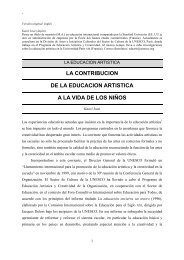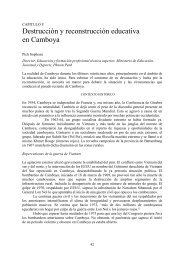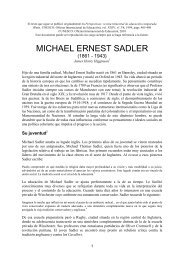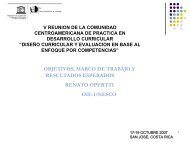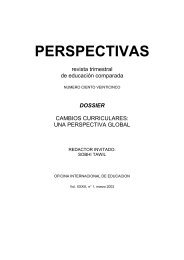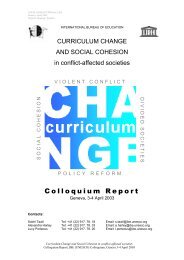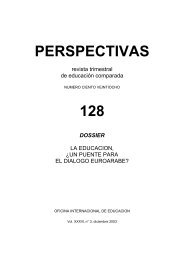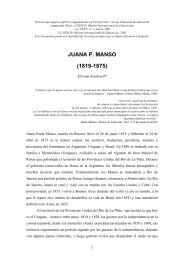Curriculum Change and Social Inclusion - International Bureau of ...
Curriculum Change and Social Inclusion - International Bureau of ...
Curriculum Change and Social Inclusion - International Bureau of ...
Create successful ePaper yourself
Turn your PDF publications into a flip-book with our unique Google optimized e-Paper software.
Responding to social exclusion<br />
through curriculum change<br />
Sobhi Tawil<br />
I. BACKGROUND<br />
1. Exclusion <strong>and</strong> strains on social cohesion<br />
Establishing stronger social cohesion within <strong>and</strong> among<br />
communities <strong>and</strong> nations is a necessary precondition for<br />
peace <strong>and</strong> stability, as well as for sustainable social <strong>and</strong><br />
economic development. The past decade has seen growing<br />
international concern with social cohesion as the social<br />
fabric in all regions <strong>of</strong> the world has increasingly been<br />
under the strain <strong>of</strong> greater inequalities in income<br />
distribution, unemployment, marginalization, xenophobia,<br />
racial discrimination, school-based violence, organized<br />
crime <strong>and</strong> armed conflict. These diverse manifestations<br />
<strong>and</strong> causes <strong>of</strong> social exclusion point to the dissolution <strong>of</strong><br />
bonds <strong>of</strong> trust between individuals <strong>and</strong> social groups, as<br />
well as to a weakening <strong>of</strong> respect for human life <strong>and</strong><br />
dignity. Furthermore, these societal strains constitute<br />
important threats to social <strong>and</strong> political stability. The<br />
concept <strong>of</strong> social cohesion therefore clearly stems from<br />
deep concern about social exclusion <strong>and</strong> the way this is<br />
reproduced <strong>and</strong> exacerbated within contexts <strong>of</strong> economic<br />
transition, economic depression <strong>and</strong> political instability.<br />
2. From exclusion to social inclusion<br />
As a result, there has been increasing focus on social<br />
inclusion in view, not only <strong>of</strong> mitigating the impact <strong>of</strong><br />
weakening social fabric <strong>and</strong> cohesion, but also <strong>of</strong> ensuring<br />
greater respect for the basic rights <strong>of</strong> individuals <strong>and</strong><br />
groups. Emphasis on social exclusion therefore translates<br />
into a desire to enhance the inclusion <strong>of</strong> all individuals <strong>and</strong><br />
groups into a pluralistic, just <strong>and</strong> cohesive society,<br />
particularly through equitable access to social services<br />
(health, education, housing, employment), security <strong>and</strong><br />
justice, as well as to other social benefits. This attempt to<br />
enhance inclusion is directed particularly at those groups<br />
that are most excluded from full social, cultural, economic<br />
<strong>and</strong> political participation: they include a wide array <strong>of</strong><br />
groups ranging from national minorities, the unemployed,<br />
youth, women, immigrants, refugees <strong>and</strong> internally<br />
displaced populations, street children, remote rural<br />
communities, people living with HIV/AIDS, asylum<br />
seekers, people with disabilities, to traveler families <strong>and</strong><br />
to the elderly. It is important to note that, in many cases,<br />
6<br />
it is a combination <strong>of</strong> multiple discriminations that leads<br />
to social exclusion <strong>of</strong> individuals <strong>and</strong> groups.<br />
3. The role <strong>of</strong> education<br />
It is now widely established that education systems <strong>of</strong>ten<br />
contribute to perpetuating social <strong>and</strong> economic disparities<br />
<strong>and</strong> inequalities as is illustrated by patterns <strong>of</strong> inequitable<br />
access to formal education based on a combination <strong>of</strong><br />
factors related to gender, income level, residence <strong>and</strong><br />
minority status. These inequities (as monitored by<br />
disparities in net enrolment ratios, retention, completion<br />
<strong>and</strong> literacy rates) are important sources <strong>of</strong> social exclusion<br />
<strong>and</strong> may be viewed as ‘part <strong>of</strong> an intricate web <strong>of</strong> human<br />
rights violations’ (World Education Forum, Dakar, 2000).<br />
Moreover, beyond educational deprivation <strong>and</strong> inequitable<br />
access to education <strong>and</strong> training, <strong>of</strong>ficial curricular content<br />
may also contribute to maintaining <strong>and</strong> reproducing<br />
stereotypes <strong>and</strong> prejudice towards certain minority groups<br />
through the languages <strong>of</strong> instruction used (or not used),<br />
the teaching <strong>of</strong> history <strong>and</strong> geography, citizenship education<br />
<strong>and</strong> so forth. Similarly, while the content <strong>and</strong> unintended<br />
consequences <strong>of</strong> schooling may act as precipitating factors<br />
in the breakdown <strong>of</strong> social cohesion, formal education also<br />
has an important role to play in strengthening or rebuilding<br />
social fabric through enhanced social inclusion<br />
(<strong>International</strong> Conference on Education, Geneva,<br />
September 2001).<br />
4. Curricula reform <strong>and</strong> life skills<br />
Educational reform to enhance social inclusion may include<br />
a wide array <strong>of</strong> measures at the levels <strong>of</strong> policy,<br />
management, curricula content <strong>and</strong> teacher training, ranging<br />
from legislative measures <strong>of</strong> positive discrimination in<br />
access to formal education, to inclusive education for<br />
learners with special needs, as well as curricular reform.<br />
Reform to update curricula by incorporating new<br />
knowledge, skills <strong>and</strong> attitudes is one important way in<br />
which the provision <strong>of</strong> education may be adapted to<br />
encourage greater social inclusion. The increasing focus<br />
on the generic curricula area <strong>of</strong> life skills is the expression<br />
<strong>of</strong> an essentially preventative <strong>and</strong> proactive perspective.<br />
At a minimal level, life skills include skills related to<br />
communication, decision-making, critical thinking,



